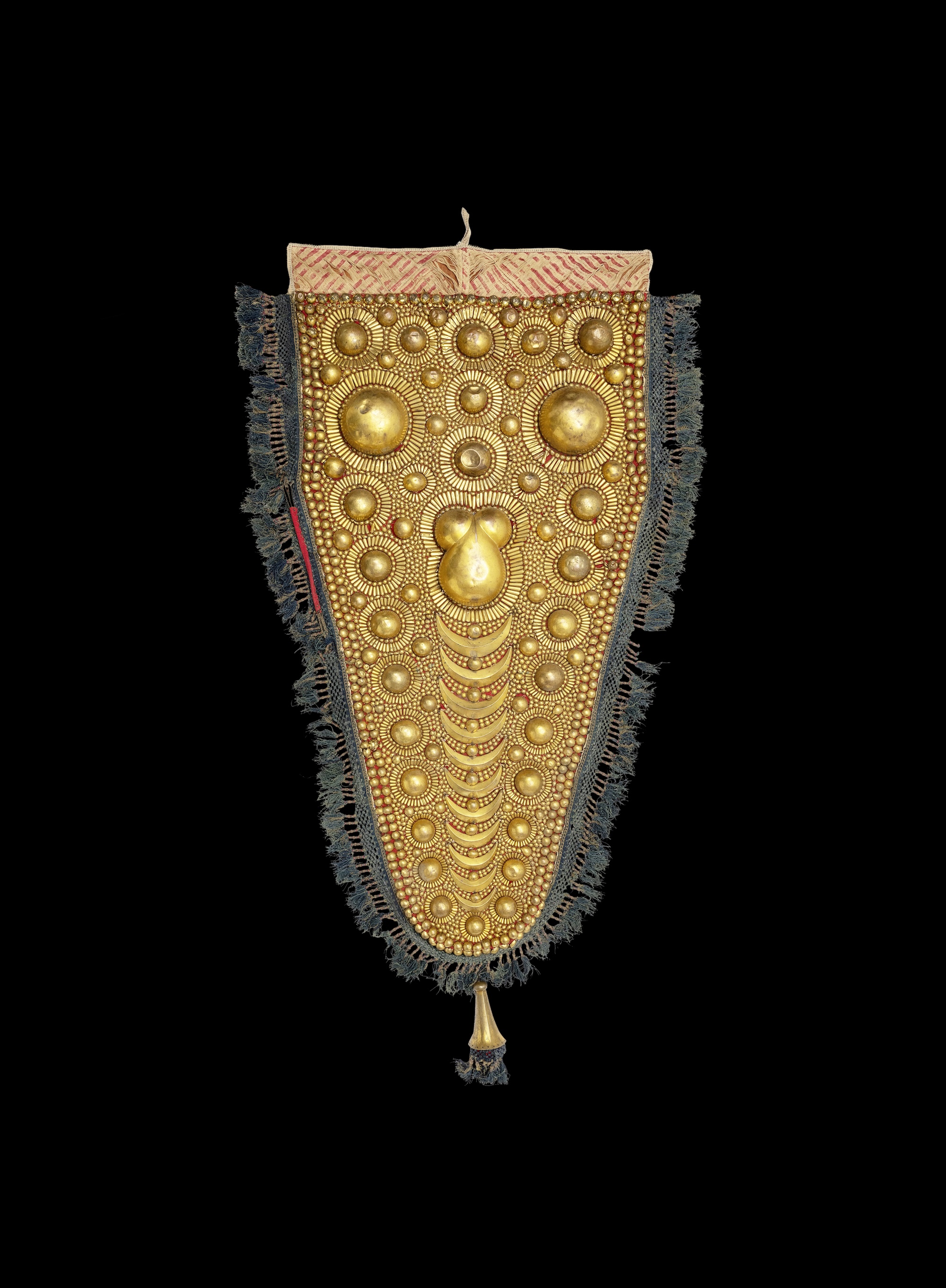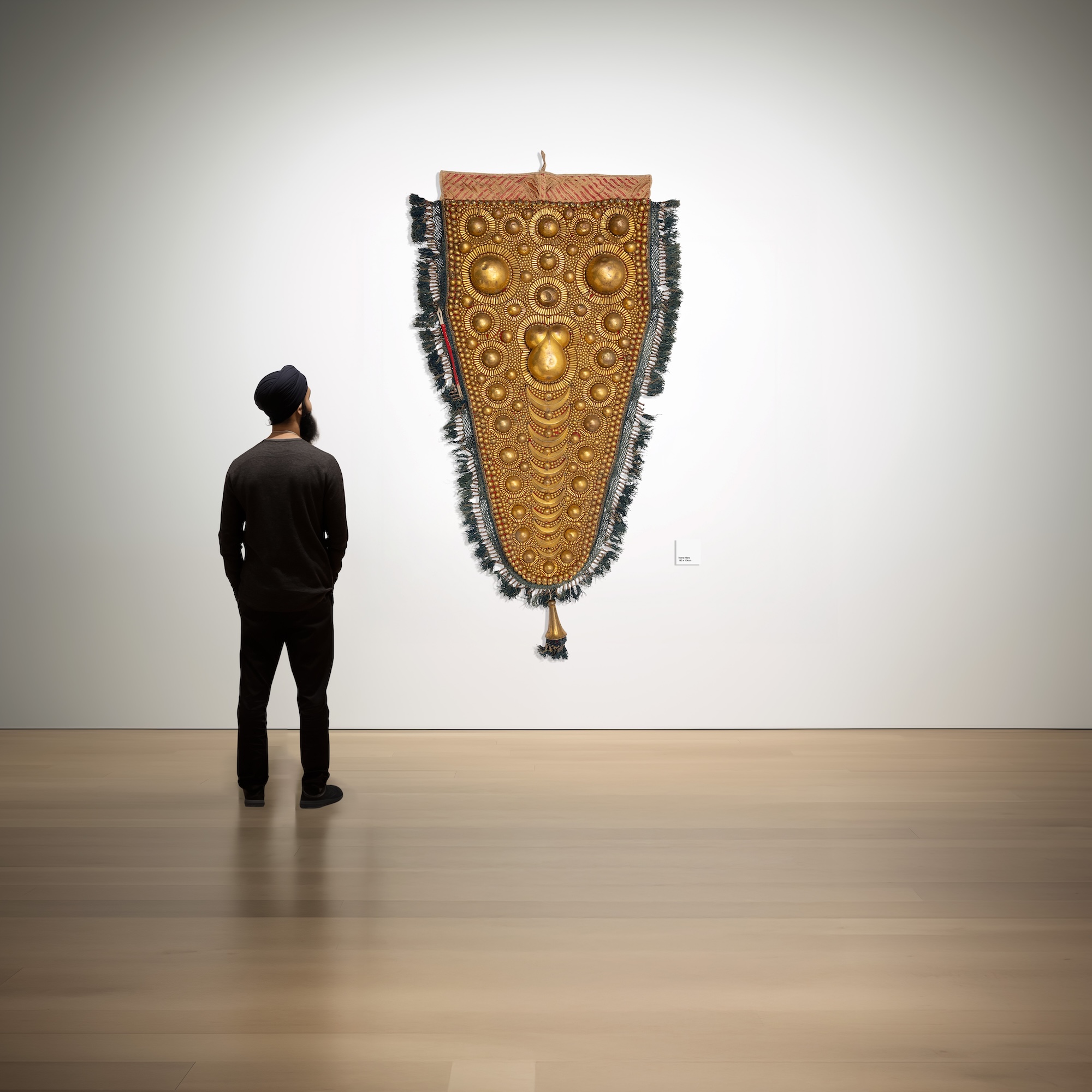Gilt-copper elephant head ornament (Nettipattam)
Kerala (India)
19th Century
Total Length: 190 cm (75 inches)
Width at Widest Point: 104 cm (41 inches)
Material: Gilt-copper, textile
Large caparison headpiece for an elephant, called nettipattam, a Mayali word meaning “forehead band”.
The piece is made of a large triangular red cotton piece adorned with hundreds of convex circular, elongated, and crescent-shaped gilt-copper elements of various sizes, stitched to the fabric. It is lined with a blue cotton fringe of elaborated trimming enriched with red silk and gilt thread. A large gilt-copper bell-shaped pendant hangs from the bottom, from which the same blue trimmings are attached. Small gilt-copper discs used to hang from the series of holes pierced on the pendant’s lower rim. The long cotton ropes were used to attach the caparison to the elephant’s head. Nettipattam are still used in Kerala today to adorn the forehead of temple elephants during festivals, processions, and other religious events. They do not only embellish the animal’s head, but are also seen as auspicious objects, referring to the first elephant head ornament created and given by Brahma to Indra’s mythical elephant, Airavata. The various gilt-copper elements and their arrangement represents various deities and symbols. The largest tripartite boss represents the Trimurthi (the divine triad composed of Vishnu, Brahma, and Shiva), while the two largest circular bosses figure the goddesses Lakhsmi (on the left), and Sarashvati (on the right). Above and between the latter, seven medium-size bosses represent the Saptarshi, the seven sages of Hindu Ancient literature whose names are associated with the seven stars of the Big Dipper constellation. Under the Lakshmi boss, a smaller one figures Vishvamitra, one of the most venerated Hindu sages, while the other one in symmetry figures Vishvakarma, the Great Architect of the Universe. The nine crescents descending from the Trimurthi boss over the elephant’s trunk personify the Navagraha, the nine cosmic deities embodying planets and other astrological phenomenon’s, who are said to be influencing human destinies. The small boss at the bottom point of the piece represents the elephant god Ganesha, while the eight other ones aligned on both side of the crescents, along the caparison’s rim, figure the eight Vasu, the Vedic deities personifying elements and other cosmic or natural concepts, and assistants to Lord Indra in the sky. All the other smaller bosses filling the whole background represent the myriad of stars filling the Universe, in which all the other deities are inserted.
Today most of these temple nettipattam are made in Thrissur and Thrippunithura, in Kerala. Beyond its temple use, hanging a nettipattam (a real one or smaller version of it) in the east-direction of a house is also used to bring good luck to someone’s home. Another example, dating from the 20th century, is preserved at the Indian Heritage Centre of Singapore. The aspect of the elaborated trimming fringe on our piece, however, points towards a rare 19th century dating, as later examples until today are using a simpler and brighter multicoloured wool fringe like the one preserved in Singapore.
Provenance
The Mohammed Khalil Collection.
Published
M. K. Ibrahim, Islamic Arms and Armour, Vol. II, United Arab Emirates, 2022, p. 805, cat. no.
659.
Condition Report:
Dents and rubbing to the gilded copper attachments, a few are partly detached. Slight discolouration and fraying to the trimmings. The top horizontal
panel is frayed and a conservation netting applied. The textile on the rear warps have become detached. Overall, very well preserved


